Caution: Idling a vehicle in an enclosed area with poor ventilation is dangerous. Engine exhaust may enter the vehicle. Engine exhaust contains Carbon Monoxide (CO) which cannot be seen or smelled. It can cause unconsciousness and even death. Never run the engine in an enclosed area that has no fresh air ventilation. For more information, see Engine Exhaust.
Caution: Over-inflating a tire could cause the tire to rupture and you or others could be injured. Be sure to read and follow the tire sealant and compressor kit instructions and inflate the tire to its recommended pressure. Do not exceed the recommended pressure.
Caution: Storing the tire sealant and compressor kit or other equipment in the passenger compartment of the vehicle could cause injury. In a sudden stop or collision, loose equipment could strike someone. Store the tire sealant and compressor kit in its original location.
If this vehicle has a tire sealant and compressor kit, there may not be a spare tire, tire changing equipment, and on some vehicles there may not be a place to store a tire.
The tire sealant and compressor can be used to temporarily seal punctures up to ¼ inch (6 mm) in the tread area of the tire. It can also be used to inflate an under inflated tire.
If the tire has been separated from the wheel, has damaged sidewalls, or has a large puncture, the tire is too severely damaged for the tire sealant and compressor kit to be effective. See Roadside Assistance Program.
Read and follow all of the tire sealant and compressor kit instructions.
The kit includes:
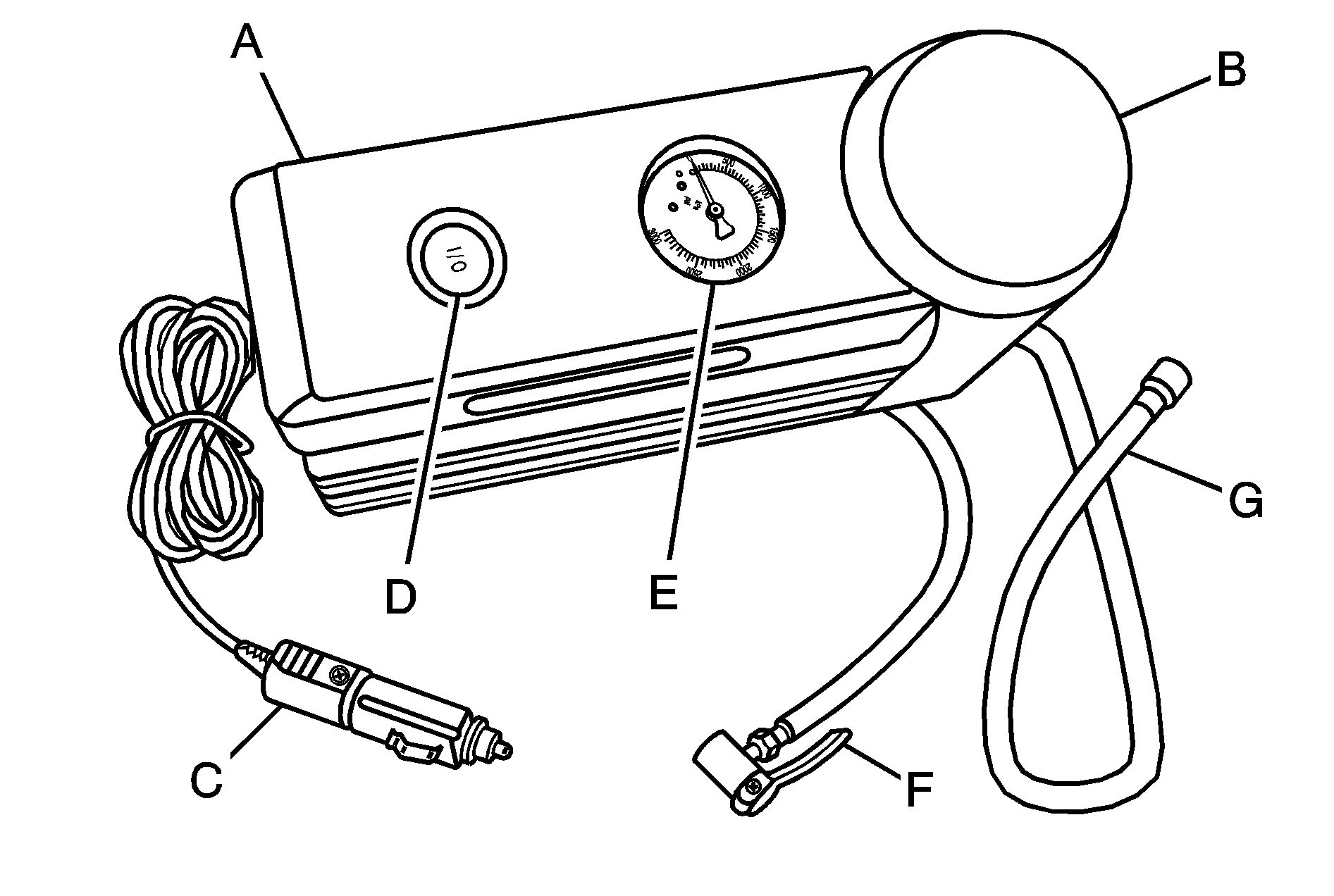
Air Compressor
Tire Sealant Canister
Power Plug
On/Off Button
Pressure Gage
Air Only Hose (Black)
Sealant/Air Hose (Clear)
Tire Sealant
Read and follow the safe handling instructions on the label adhered to the sealant canister.
Check the tire sealant expiration date on the sealant canister. The sealant canister should be replaced before its expiration date. Replacement sealant canisters are available at your local dealer/retailer. See "Removal and Installation of the Sealant Canister" following.
There is only enough sealant to seal one tire. After usage, the sealant canister and sealant/air hose assembly must be replaced. See "Removal and Installation of the Sealant Canister" following.
Using the Tire Sealant and Compressor Kit to Temporarily Seal and Inflate a Punctured Tire
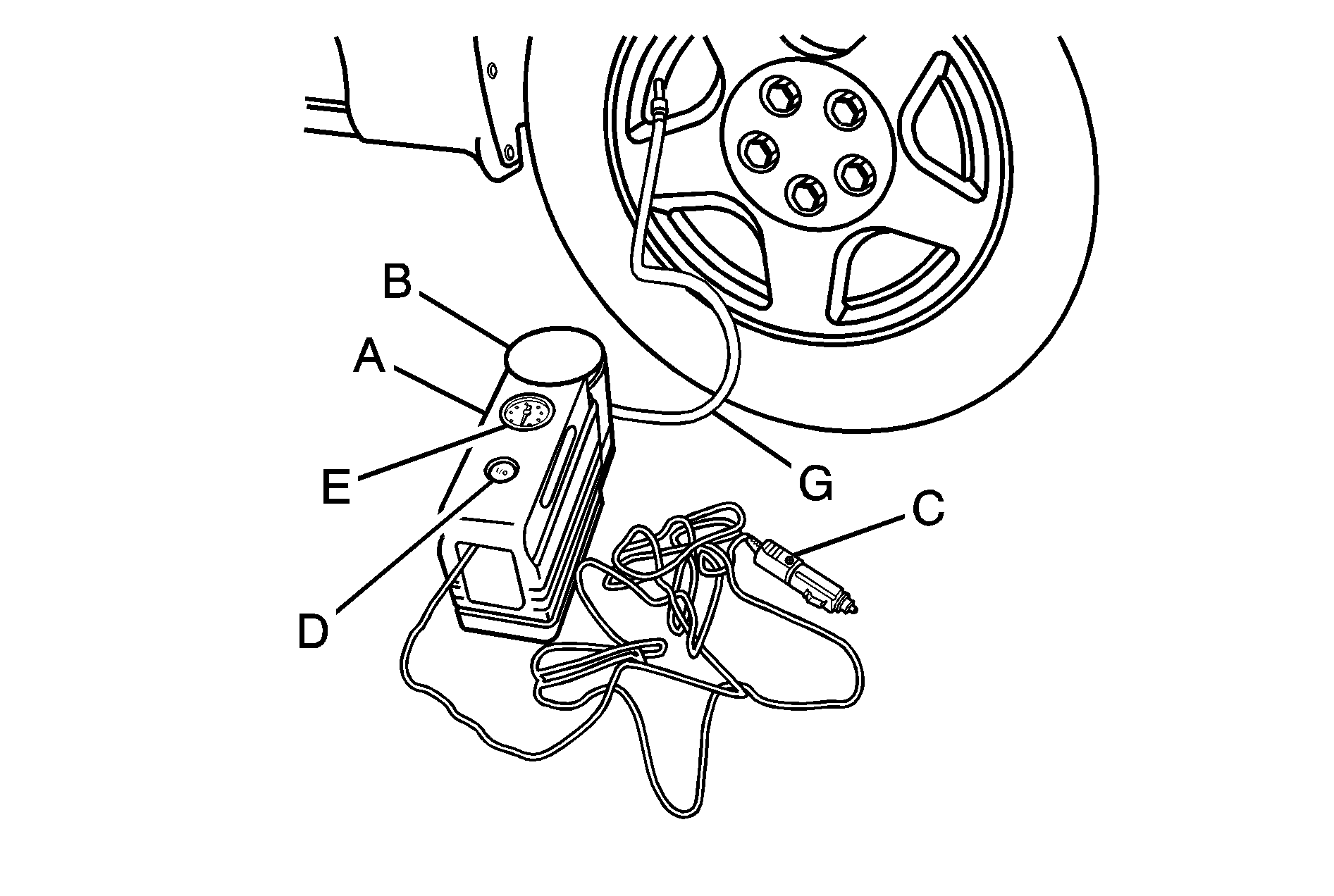
When using the tire sealant and compressor kit during cold temperatures, warm the kit in a heated environment for 5 minutes. This will help to inflate the tire faster.
Always do a safety check first. See If a Tire Goes Flat. Do not remove any objects that have penetrated the tire.
- Remove the tire sealant and compressor kit from its storage location. See Tire Sealant and Compressor Kit Storage.
- Unwrap the sealant/air hose (F) and the power plug (C).
- Place the kit on the ground.
- Remove the valve stem cap from the flat tire by turning it counterclockwise.
- Attach the sealant/air hose (F) onto the tire valve stem. Turn it clockwise until it is tight.
- Plug the power plug (C) into the accessory power outlet in the vehicle. Unplug all items from other accessory power outlets. See Accessory Power Outlet(s).
- Start the vehicle. The vehicle must be running while using the air compressor.
- Press the on/off (D) button to turn the tire sealant and compressor kit on.
- Inflate the tire to the recommended inflation pressure using the pressure gage (E). The recommended inflation pressure can be found on the Tire and Loading Information label. See Inflation - Tire Pressure.
- Press the on/off button (D) to turn the tire sealant and compressor kit off.
- Unplug the power plug (C) from the accessory power outlet in the vehicle.
- Turn the sealant/air hose (F) counterclockwise to remove it from the tire valve stem.
- Replace the tire valve stem cap.
- Replace the sealant/air hose (F), and the power plug (C) back in their original location.
- The label is a reminder not to exceed 55 mph (90 km/h) until the damaged tire is repaired or replaced.
- Return the equipment to its original storage location in the vehicle.
- Immediately drive the vehicle 5 miles (8 km) to distribute the sealant in the tire.
- Stop at a safe location and check the tire pressure. Refer to Steps 1 through 11 under "Using the Tire Sealant and Compressor Kit without Sealant to Inflate a Tire (Not Punctured)."
- Wipe off any sealant from the wheel, tire or vehicle.
- Dispose of the used sealant canister (B) and sealant/air hose (F) assembly at a local dealer/retailer or in accordance with local state codes and practices.
- Replace it with a new canister available from your dealer/retailer.
- After temporarily sealing a tire using the tire sealant and compressor kit, take the vehicle to an authorized dealer/retailer within a 100 miles (161 km) of driving to have the tire repaired or replaced.
Make sure the on/off button (D) is in the off (O) position.
Make sure the tire valve stem is positioned close to the ground so the hose will reach it.
If the vehicle has an accessory power outlet, do not use the cigarette lighter.
If the vehicle only has a cigarette lighter, use the cigarette lighter.
Do not pinch the power plug cord in the door or window.
The compressor will inject sealant and air into the tire.
The pressure gage (E) will initially show a high pressure while the compressor pushes the sealant into the tire. Once the sealant is completely dispersed into the tire, the pressure will quickly drop and start to rise again as the tire inflates with air only.
The pressure gage (E) may read higher than the actual tire pressure while the compressor is on. Turn the compressor off to get an accurate pressure reading. The compressor may be turned on/off until the correct pressure is reached.
Notice: If the recommended pressure cannot be reached after approximately 25 minutes, the vehicle should not be driven farther. The tire is too severely damaged and the tire sealant and compressor kit cannot inflate the tire. Remove the power plug from the accessory power outlet and unscrew the inflating hose from the tire valve. See Roadside Assistance Program .
The tire is not sealed and will continue to leak air until the vehicle is driven and the sealant is distributed in the tire, therefore, Steps 11 through 17 must be done immediately after Step 10.
Be careful while handling the tire sealant and compressor kit as it could be warm after usage.
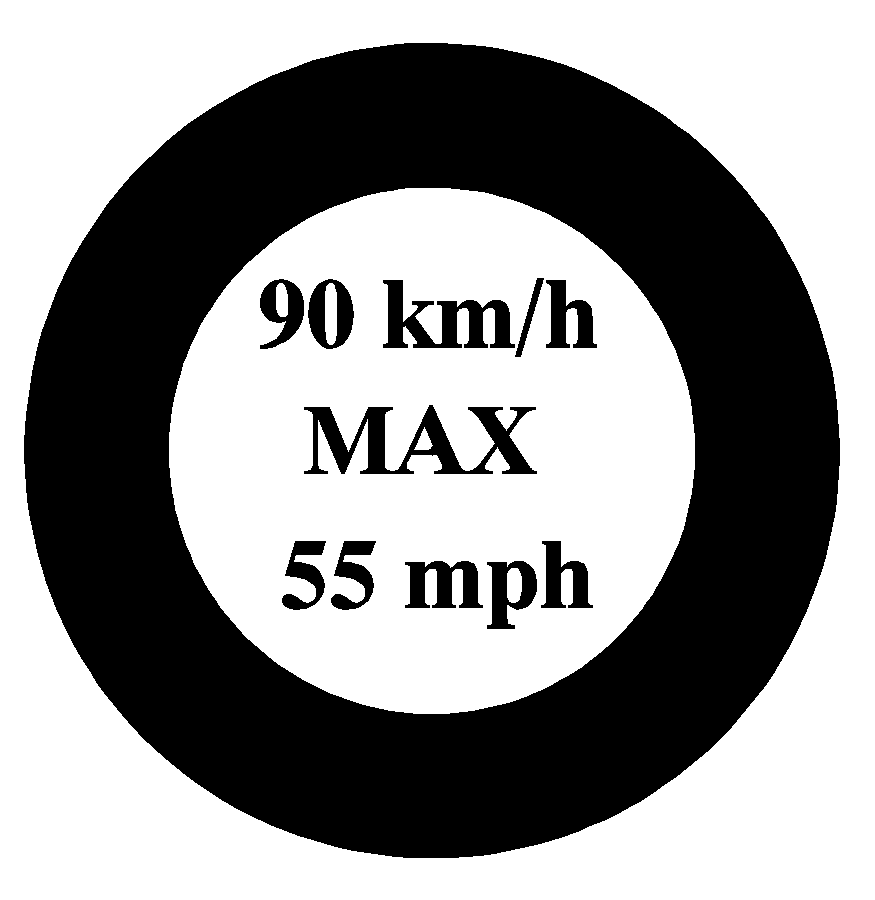
If the flat tire was able to inflate to the recommended inflation pressure, remove the maximum speed label from the sealant canister (B) and place it in a highly visible location.
If the tire pressure has fallen more than 10 psi (68 kPa) below the recommended inflation pressure, stop driving the vehicle. The tire is too severely damaged and the tire sealant cannot seal the tire. See Roadside Assistance Program.
If the tire pressure has not dropped more than 10 psi (68 kPa) from the recommended inflation pressure, inflate the tire to the recommended inflation pressure.
Using the Tire Sealant and Compressor Kit without Sealant to Inflate a Tire (Not Punctured)
To use the air compressor to inflate a tire with air only and not sealant:
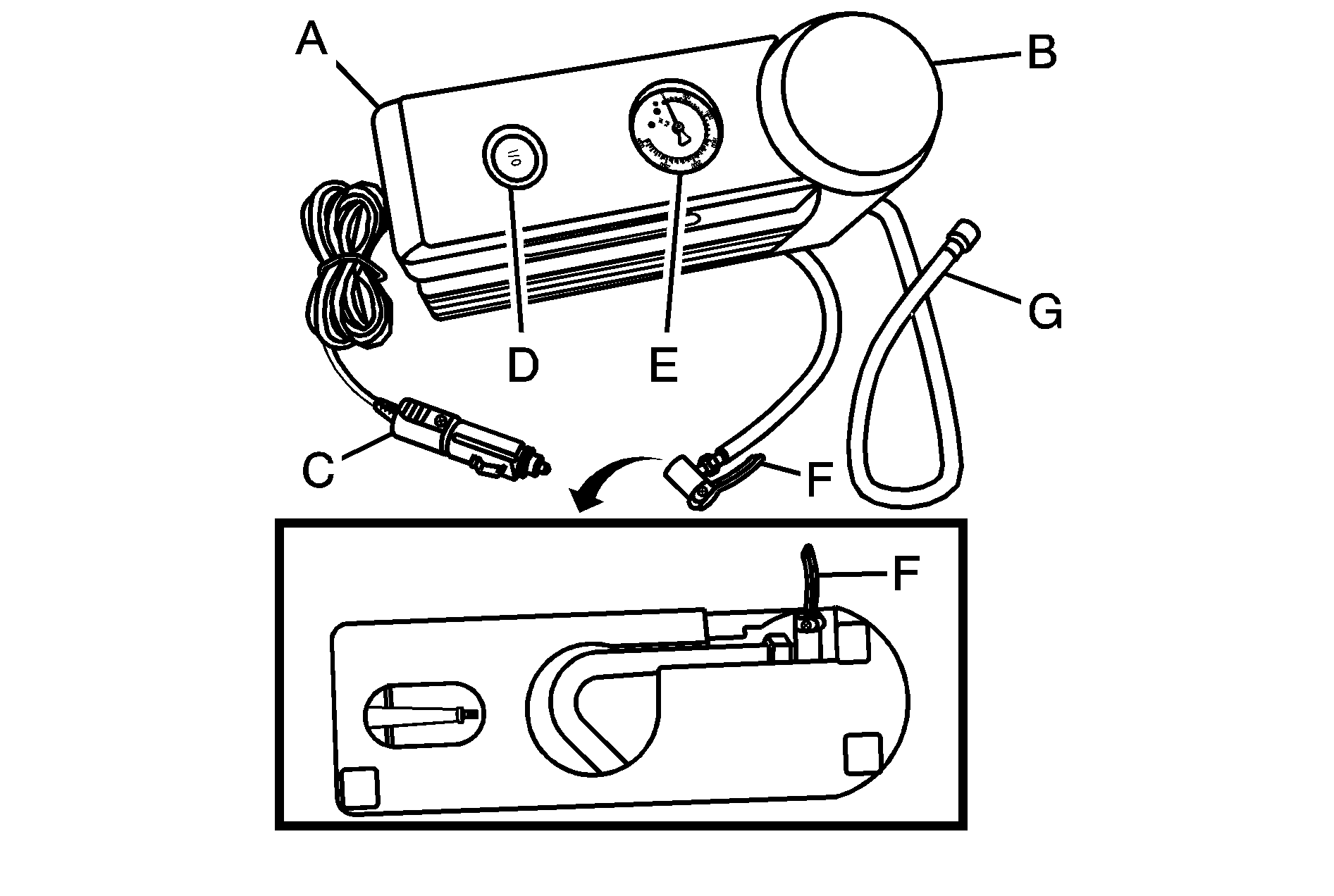
Always do a safety check first. See If a Tire Goes Flat.
- Remove the tire sealant and compressor kit from its storage location. See Tire Sealant and Compressor Kit Storage.
- Unlock the air only hose (F) from the sealant canister (B) by pulling up on the lever.
- Pull the air only hose (F) from the sealant canister (B).
- Remove the power plug (C) from the air compressor (A).
- Place the kit on the ground.
- Remove the tire valve stem cap by turning it counterclockwise.
- Attach the air only hose (F) onto the tire valve stem and press the lever down to secure it.
- Plug the power plug (C) into the accessory power outlet in the vehicle. Unplug all items from other accessory power outlets. See Accessory Power Outlet(s).
- Start the vehicle. The vehicle must be running while using the air compressor.
- Press the on/off (D) button to turn the compressor on.
- Inflate the tire to the recommended inflation pressure using the pressure gage (E). The recommended inflation pressure can be found on the Tire and Loading Information label. See Inflation - Tire Pressure.
- Press the on/off button (D) to turn the tire sealant and compressor kit off.
- Unplug the power plug (C) from the accessory power outlet in the vehicle.
- Disconnect the air only hose (F) from the tire valve stem, by turning it counterclockwise, and replace the tire valve stem cap.
- Replace the air only hose (F) and the power plug (C) back in its original location.
- Place the equipment in the original storage location in the vehicle.
Make sure the tire valve stem is positioned close to the ground so the hose will reach it.
If the vehicle has an accessory power outlet, do not use the cigarette lighter.
If the vehicle only has a cigarette lighter, use the cigarette lighter.
Do not pinch the power plug cord in the door or window.
The compressor will inflate the tire with air only.
The pressure gage (E) may read higher than the actual tire pressure while the compressor is on. Turn the compressor off to get an accurate reading. The compressor may be turned on/off until the correct pressure is reached.
Be careful while handling the tire sealant and compressor kit as it could be warm after usage.
Removal and Installation of the Sealant Canister
To remove the sealant canister:
- Unlock the air only hose (F) from the sealant canister (B) by pulling up on the lever.
- Pull the air only hose (F) from the sealant canister (B).
- Unwrap the sealant/air hose (F) from the compressor (A).
- Turn the sealant canister (B) so the inflator filling hose is aligned with the slot in the compressor.
- Lift the sealant canister (B) from the compressor and replace with a new sealant canister. See your dealer/retailer for more information.
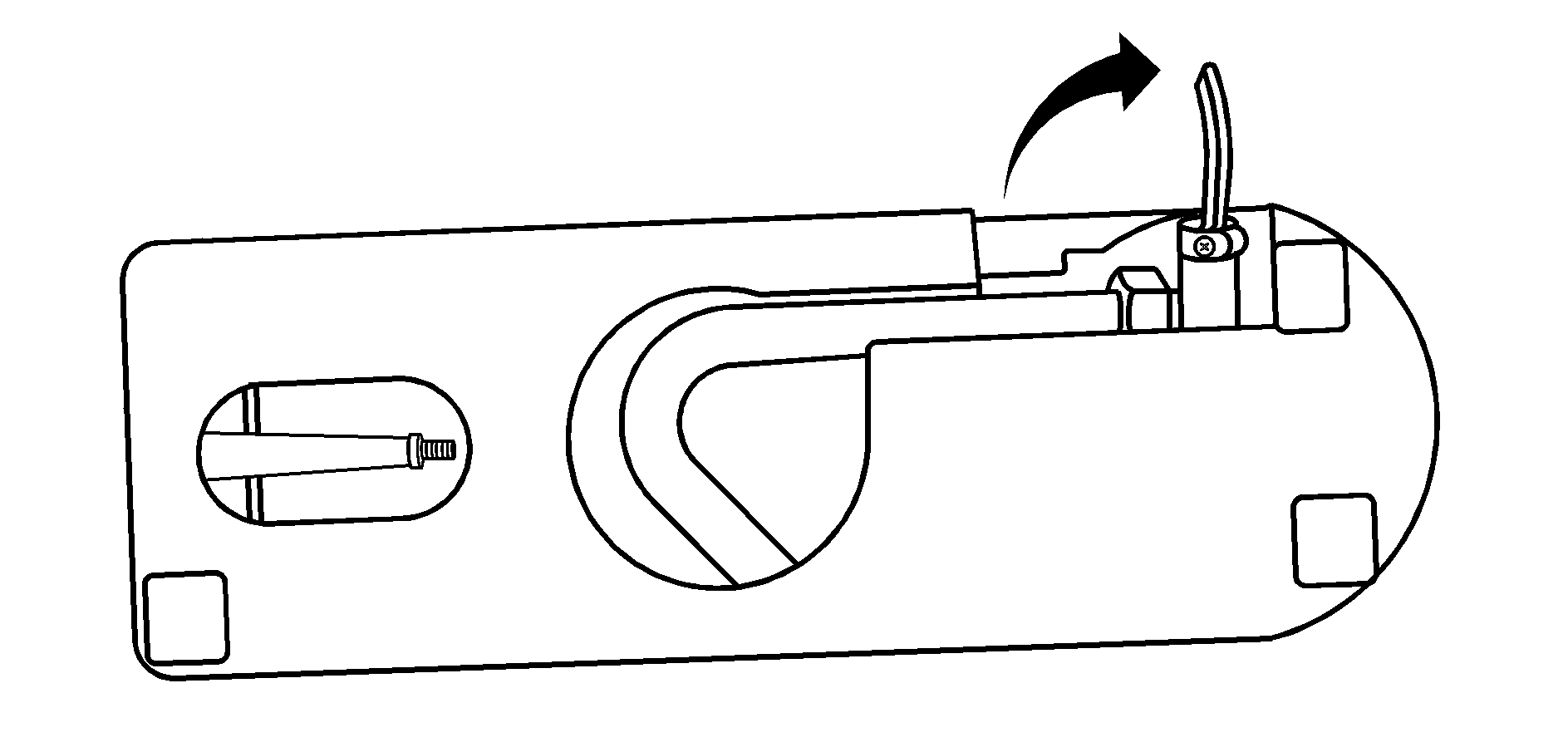

To install a new sealant canister:
- Align the sealant/air hose (F) with the slot in the air compressor.
- Push the sealant canister (B) down and turn it clockwise.
- Wrap the sealant/air hose (F) around the air compressor channel to stow it in its original location.
- Push the air compressor inflator hose (F) onto the sealant canister inlet and push the lever down.
